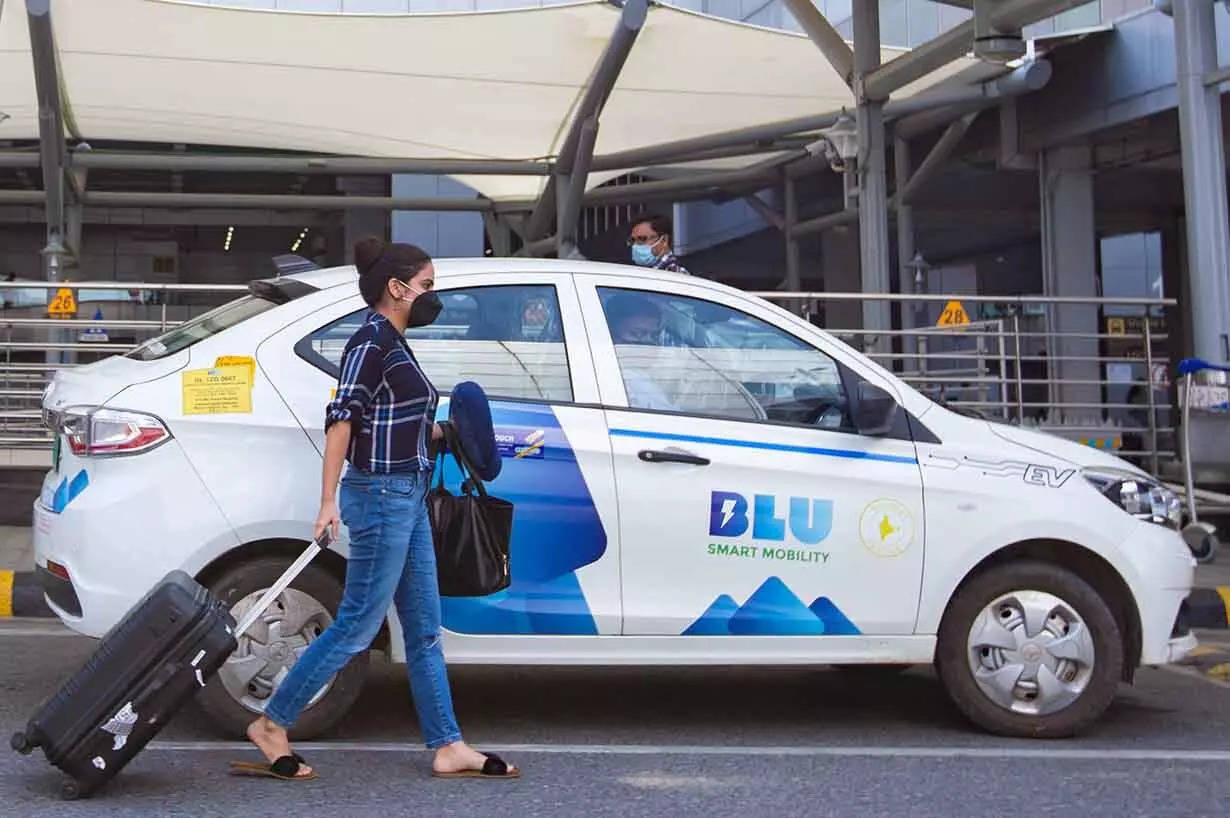
The Electric Vehicle ( EV) based ride-hailing story, which began unsuccessfully with an USD 8 mn foray by Ola in the Western city of Nagpur in 2017, has lately seen renewed action with dominant players Ola and Uber planning big moves even as startups like BluSmart have flipped the typical model of cab-aggregators.
While Uber recently signed a deal with Tata Motors to buy 25,000 electric cars, Ola earlier said it will roll out 10,000 EV cabs in Bengaluru over a period of a year. The upstart in the segment, BluSmart though, operates a fleet of electric cars leased directly and deploys the fleet with salaried drivers, unlike competitors who do not themselves own any vehicles.
The Uber-Tata Motors deal is a slight shift in stance, wherein the San Francisco-based firm will let its fleet partners purchase cars for deployment, thereby ensuring a certain level of ride quality, the lack of which lately became a moat for BluSmart.
While Bhavish Aggarwal-led Ola plans to list its ‘premium’ EV cabs as a separate category in the app, people in the know said. Uber, on the other hand, is initially integrating with its existing premium services like rentals and Uber Premier.
According to those tracking the segment, both business models – deployed by BluSmart and by Uber and Ola – come with their own sets of opportunities and threats.
“BluSmart is attempting to grow carefully and sustainably, and therefore much of its strategy depends on its ability to deploy cars to address the demand it is creating,” a New Delhi-based investor in mobility startups told ET. “The Uber-Tata MoU has shown that bigger players with deeper pockets might try to steamroll the space.”
BluSmart’s growth strategy depends heavily on its ability to continue adding vehicles to its fleet.
“Out of 100 new customers, maybe 10 new come to us because we are electric while the rest are there for the service that we offer…like no cancellation, no surge price. This is because we do not ask our driver partners to own these assets,” Anmol Singh Jaggi, co-founder of BluSmart, told ET.
Existing production constraints of major EV automakers and the entry of Uber and Ola which will grab a share of their production line means BluSmart’s strategy could be called into question.
Supply puzzle
A person familiar with Ola’s thinking said the crucial issue is the supply of cars.
“Anyone can run a fleet of a few hundred cars, but this business is about network effects; till that is addressed, the segment will stay small,” the person said.
Ola is planning to start its own EV cab service and will begin the pilot in Bengaluru with around 1,000 cabs, ET was the first to report on January 4. The cabs will be available on the Ola app as a separate category along with regular cabs and its auto service. What’ll be significant is how Ola integrates its planned four-wheeler electric cars once they are launched in a year or so with its cab-hailing business.
After its failed project in Nagpur which was in partnership with vehicle manufacturer Mahindra & Mahindra, the Bengaluru-based mobility company has big ambitions for this segment, said people close to the matter.
Uber’s ability to scale up its EV business depends on the demand as well as supply of cabs from Tata Motors, Prabhjeet Singh, president, Uber India and South Asia, told ET.
“It depends on how the demand side picks up and the ability of Tata Motors to deliver these many cars, but we are looking at a three-year timeframe,” Singh said on its ability to deploy 25,000 cabs.
Tata Motors expects to shore up production to 100,000 units by FY24.
The company scales up its supply based on demand, Shailesh Chandra, managing director of Tata Motors’ passenger vehicles and electric mobility businesses, told ET.
“As we look at our journey over the last many quarters, we were supplying about 1,500 to 1,600 vehicles every quarter, six-seven quarters ago, which has now increased to 12,000-13,000 vehicles a quarter. We have built enough capacity to go ahead and take these orders,” he said referring to the company’s deal with Uber. Chandra also said that the company can adjust its production line to sell more vehicles to fleet operators it required.
Ahead of the Tata Motors announcement, Uber had been conducting a pilot with fleet partners to assess the viability of its electric vehicle products, which it priced 20-25% above its entry-level UberGo offering.
BluSmart way
While BluSmart continues to work on improving its unit economics on the utilisation side, it said cost reductions will only come in the form of smaller EVs.
“From Day One, we have not been dependent on public charging infrastructure. Three years ago, and even now, we know that public infrastructure won’t be sufficient to support the kind of operations we want to run. It cannot support the thousands of fleet cars that we have. Neither are they sufficient in quantity nor good in terms of reliability,” Jaggi said. “Other cab aggregators who plan to go electric will have to solve for charging.”
Jaggi said driver partners will make money only if the car is on the road for a given number of hours in a day.
“But that will be difficult if they spend their time looking for chargers, waiting in queues or facing reliability issues with charging points,” he added.
The company currently operates in Delhi-National Capital Region and Bengaluru.
EVs require a separate algorithm on the backend as it has to take into consideration the range of the vehicle, the level of charge in its battery and the proximity of the charging station before allotting a ride to the driver.
“Form factors available in India tend to have a lower range than what is available in international markets, public charging infrastructure is still taking shape, most of the fleet operators have some captive charging capacity in place, so the technology should reflect that. This is a work in progress journey,” Uber’s Singh said.
Uber has an EV algorithm from international markets already that can be incorporated within the limitations of the Indian EV ecosystem.
While BluSmart has a patented algorithm, Jaggi said it is a matter of time before others replicate it.
Even as BluSmart scales up to more cities, he said the company will be able to maintain the quality of service as it won’t be operating in more than six cities.
“I think we have enough market data which shows that more than 80% of the ride-hailing business happens in the top six cities,” he said. “Operating in the 94 other cities will be loss-making.”
















